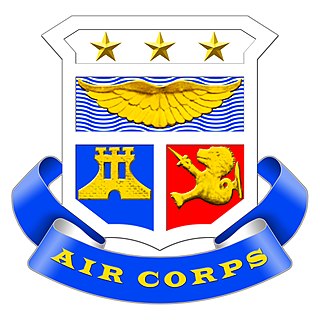
The Philippine Army Air Corps was created in 1935 as the air component of the Philippine Army. It was the predecessor of the Philippine Air Force, created in 1947.

Nichols Field was a U.S. military airfield located south of Manila in Pasay and Parañaque, Metro Manila, Luzon, the Philippines. The complex is located at Andrews Avenue by the north, Domestic Road by the west, NAIA Road and Ninoy Aquino Avenue by the southwest, Multinational Avenue by the south, South Luzon Expressway and the Metro Manila Skyway by the east, and Sales Street by the northeast.

The Martin B-26 Marauder is an American twin-engined medium bomber that saw extensive service during World War II. The B-26 was built at two locations: Baltimore, Maryland, and Omaha, Nebraska, by the Glenn L. Martin Company.
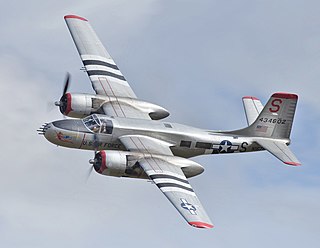
The Douglas A-26 Invader is an American twin-engined light bomber and ground attack aircraft. Built by Douglas Aircraft Company during World War II, the Invader also saw service during several major Cold War conflicts. A limited number of highly modified United States Air Force aircraft served in Southeast Asia until 1969. It was a fast aircraft capable of carrying a large bomb load. A range of guns could be fitted to produce a formidable ground-attack aircraft.
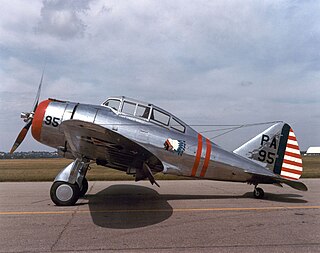
The Seversky P-35 is an American fighter aircraft built by the Seversky Aircraft Company in the late 1930s. A contemporary of the Hawker Hurricane and Messerschmitt Bf 109, the P-35 was the first single-seat fighter in United States Army Air Corps to feature all-metal construction, retractable landing gear, and an enclosed cockpit.

The Boeing P-12 or Boeing F4B was an American pursuit aircraft that was operated by the United States Army Air Corps, United States Marine Corps, and United States Navy. It was the chief fighter aircraft in American service during the early 1930s but also used internationally. By the late 1930s it was replaced in front-line duty by newer designs, but it was still used for training into the early 1940s. Many variants of the aircraft were developed. In the 21st century a handful of surviving air frames are on display in museums.

The Curtiss P-6 Hawk is an American single-engine biplane fighter introduced into service in the late 1920s with the United States Army Air Corps and operated until the late 1930s prior to the outbreak of World War II.
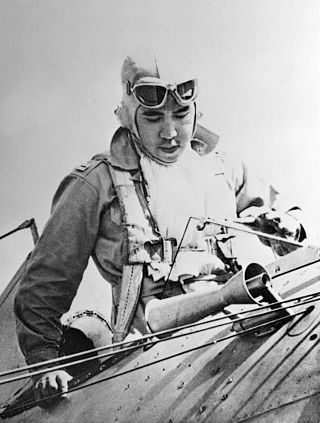
Jesús Antonio Villamor was a Filipino-American pilot, spy, and Medal of Valor awardee who fought the Japanese in World War II.
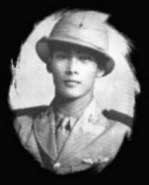
César Fernando María Tianko Basa was a Filipino military pilot who fought in World War II. He was one of the pioneer fighter pilots of the Philippine Army Air Corps, the forerunner of the Philippine Air Force, and was the first Filipino fighter pilot casualty during World War II.

The 55th Fighter Squadron is part of the 20th Fighter Wing at Shaw Air Force Base, South Carolina. It operates the General Dynamics F-16 Fighting Falcon aircraft conducting air superiority missions.

The 6th Weapons Squadron is an active United States Air Force unit. It is assigned to the USAF Weapons School, based at Nellis Air Force Base, Nevada. It was previously assigned to the Seventh Air Force, being inactivated at Yokota Airfield, Japan on 20 February 1947.

Scarlett Martínez International Airport, also known as Río Hato Airport, is an international airport serving Río Hato, a town in the Coclé Province of Panama. The airport is 3 kilometres (2 mi) east of Río Hato.

The 51st Fighter Squadron is an inactive United States Air Force unit. Its last assignment was with the 6th Fighter Wing, based at Howard Field, Canal Zone. It was inactivated on 15 October 1946.

The 24th Fighter Squadron is a United States Air Combat Command unit, assigned to the 495th Fighter Group at Naval Air Station Joint Reserve Base Fort Worth, Texas. The squadron was activated in 2019 and flies the F-35A as an active associate unit of the 457th Fighter Squadron.

The 52nd Fighter Squadron is an active reserve unit of the United States Air Force, assigned to the 944th Operations Group, 944th Fighter Wing. Stationed at Luke Air Force Base, Arizona, the squadron was most recently activated on 6 August 2021. Previously, it was with the Western Air Defense Force, based at Hamilton Air Force Base, California until its inactivation on 8 June 1951.
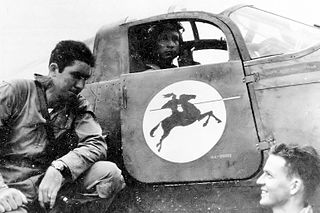
The 30th Fighter-Bomber Squadron is an inactive United States Air Force unit. Its last assignment was with the 37th Fighter-Bomber Wing, based at Clovis Army Airfield, New Mexico. It was inactivated on 25 June 1953.

The 17th Weapons Squadron is a United States Air Force unit, assigned to the USAF Weapons School at Nellis Air Force Base, Nevada.

The 37th Operations Group is an inactive unit of the United States Air Force. It was last active at Tonopah Test Range Airport, Nevada, where it operated F-117 Nighthawk fighters. Its history and honors have been temporarily bestowed upon the 37th Training Wing.
The Philippine Department Air Force was a military formation of the United States Army Air Forces.
Jose Protacio Cangco Gozar was a Filipino military aviator and a flight officer of the Philippine Army Air Corps, who was awarded at the outbreak of World War II the Distinguished Service Cross.



























